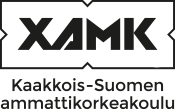Service conceptualization (5 cr)
Code: PY00CX64-3003
General information
Enrollment
16.12.2019 - 10.01.2020
Timing
01.01.2020 - 01.04.2020
Number of ECTS credits allocated
5 op
Virtual portion
3 op
RDI portion
5 op
Mode of delivery
40 % Contact teaching, 60 % Distance learning
Campus
Kouvola Campus
Teaching languages
- Finnish
Seats
20 - 30
Degree programmes
- Degree Programme in Service Design
Teachers
- Sanna Haapanen
- Marjo Suviranta
Teacher in charge
Marjo Suviranta
Groups
-
PAKV19SYService design, master studies
Objective
You can specify the objectives and definitions for the service concept based on research.
You can utilize brainstorming methods innovatively and widely in developing the concept.
You can visualize the planning, estimate it and design alternative solutions together with the interest groups.
Content
How do you design and carry out a service concept for a chosen task field?
How do you analyze and justify the choices made in the different phases?
How do you present a planned service concept to the interest groups?
Location and time
Contact the teacher
Web Studies, Contact lessons, Independent working
Materials
Keinonen, T. & Jääskö, V. (toim.) 2004 Tuptekonseptointi. Helsinki: Teknologiainfo Teknova Oy
Kettunen, T. 2001. Muodon palapeli. Helsinki: WSOY
Koivisto, M. 2007. Mitä palvelumuotoilu on? -Muotoilun hyödyntäminen palvelumuotoilun suunnittelussa. Taiteen maisterin lopputyö.
Kokkonen, V. Kuuva, M., Leppimäki, S., Lähteinen, V., Meristö, T., Piira, S. & Sääskilahti, M.2005.
Visioiva tuotekonseptointi. Työkalu tutkimus- ja kehitystoiminnan ohjaamiseen. Helsinki: Teknologiainfo Teknova Oy
Miettinen, S. (toim.) Palvelumuotoilu menetelmiä käyttäjätiedon hankintaan ja hyödyntämiseen. Helsinki: Teknologiainfo Teknova Oy, 105-121
Osterwalder, A., Pigneur, Y., Bernarda, G. & Smith, A. 2014. Value Proposition Design. How to create products and services customer want. New Jersey: John Wiley & Sons Inc
Stickdorn, M. & Schneider, J. (EDS.) 2012. This is service design thinking. Basics -Tools - Cases. Amsterdam: BIS Publishers
Tuulaniemi, J. 2011. Palvelumuotoilu
Ulrich ja Eppinger 2012 mallit
Teaching methods
Scheduled track:
Teaching organized according to timetable, in addition to working order share of the independent work as agreed.
Independent track:
The learning process that has been integrated into the work will be possible if in your assignments you can develop the know-how that has been mentioned in the objectives and contents of the study module. Contact the teacher of the study module before the beginning of the study module in good time to determine it
• is the learning process that has been integrated into the work possible in your own assignment
• what kind evidence you are able to give from your know-how
• witch parts of the study module you have to participate in teaching
Blended track:
Contact the teacher
Web Studies, Contact lessons, Independent working
Completion alternatives
The learning process that has been integrated into the work will be possible if in your assignments you can develop the know-how that has been mentioned in the objectives and contents of the study module. Contact the teacher of the study module before the beginning of the study module in good time to determine it
• is the learning process that has been integrated into the work possible in your own assignment
• what kind evidence you are able to give from your know-how
• witch parts of the study module you have to participate in teaching
Student workload
5 Cr is 135 h
Assessment criteria, approved/failed
Good 3-4
a. To critically acquire, handle, produce, and evaluate multidisciplinary knowledge related to project management and issues related
b. To solve demanding problems through research, development and/or innovation
Further information
Design Thinking and Service Design
Evaluation scale
1-5
Assessment methods and criteria
It is estimated: learning exercises and the student's self-reflection.
Grounds: contents, plane of exercises and the student's own estimate of the learning.
Active participation and approved assignments
Excellent (5), Good (4-3), Satisfactory (2-1) Fail (0)
